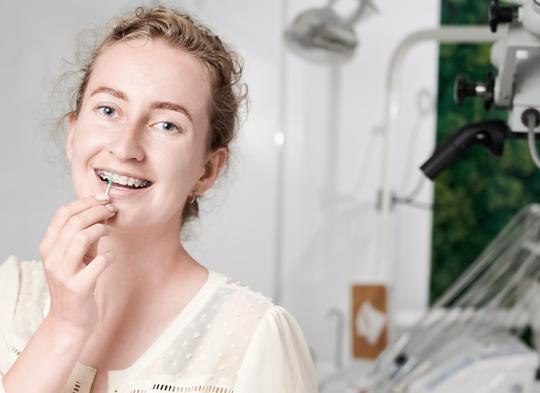The decision to get braces isn’t always driven by aesthetics only. Sometimes it’s caused by having biting difficulties, worn-down teeth, chronic jaw joint pain, or preparing for implants.
It’s not uncommon for adults to postpone orthodontic treatment for years. Often, a specific issue such as a loose tooth or problems with oral hygiene becomes the turning point. Orthodontic treatment in adults is slightly different than in children, but the goal is the same: restoring bite balance and improving the function of the stomatognathic system.
This article explains when braces are the right choice for adults, what the main indications are, and what realistic results can be achieved.
Orthodontic Treatment Is Not Limited by Age
There is no upper age limit for orthodontic treatment. The fact that teeth have stopped growing doesn’t mean they can’t be moved. Tooth movement is possible in adults just as it is in teenagers – the only difference is the pace and the scope of treatment.
Adult orthodontic treatment often requires a comprehensive plan. It must take into account existing restorations, possible gum recession, periodontal health, and sometimes missing teeth or prior extractions. Working close with a periodontist, prosthodontist, or implantologist is often necessary.
Some conditions can exclude orthodontic treatment – for example, active gum disease, lack of the patient’s cooperation, or significant general medical contraindications. However, age alone is not a reason to forgo treatment.
Relative and Absolute Contraindications for Adult Orthodontic Treatment
Orthodontic treatment isn’t possible for everyone. While age isn’t a barrier, there are cases where treatment needs to be postponed or avoided altogether. Contraindications for orthodontic treatment are divided into relative and absolute.
Relative contraindications are conditions that require preliminary treatment or preparation before braces can be fitted. They include:
- Untreated periodontal disease – gum inflammation, pockets, or bleeding during brushing. Teeth must be stabilized before any orthodontic treatment is applied.
- Poor oral hygiene – if a patient struggles to maintain hygiene without braces, wearing them will only worsen the problem. Proper brushing and flossing habits must be established first.
- Tooth decay or enamel damage – cavities and cracks need to be treated before starting orthodontic treatment.
- Lack of patient cooperation — orthodontics requires regular visits, following the recommendations, and lifestyle adjustments. Without this, lasting results are hard to achieve.
- Jaw joint problems (TMJ disorders) — they don’t exclude treatment but require close cooperation with the orthodontist and often a physiotherapist.
Absolute contraindications make orthodontic treatment impossible or too risky. These include:
- Advanced, active periodontitis – tooth instability associated with significant bone loss can lead to further loosening and tooth loss.
- Specific systemic diseases – uncontrolled diabetes or active autoimmune conditions that affect healing and tissue resistance.
- Lack of patient consent – orthodontic treatment is a long-term process, and patient engagement is essential.
Some of these obstacles can be addressed, while others require careful risk assessment and discussion with your doctor. In some cases, limited orthodontic treatment may be possible, e.g., to create space for an implant without correcting the entire bite.
Types of Malocclusions (“Bad Bite”): Crowding, Spacing, Overbite, Open Bite
Many adults choose orthodontic treatment due to a “bad bite” that was ignored or worsened over time. Some had problems since childhood that were never corrected, while others developed them later due to missing teeth or changing jaw alignment.
With age, teeth can move, arches may narrow, and even minor misalignments can become more noticeable and troublesome. Patients often adapt to an uneven bite until specific problems arise – worsening malocclusion, shifting teeth, jaw joint discomfort, or oral hygiene difficulties.
For adults, orthodontics is often about function, not just aesthetics. The goal is to restore bite balance so that chewing is evenly distributed, teeth don’t wear down, and oral hygiene is easier. In many cases, it’s the only way to stop progression and prevent the need for prosthetic treatment.
Problems with Biting, Chewing, and Tooth Wear
Difficulties with biting or chewing signal that the bite isn’t functioning properly. Patients often adapt to uneven contact between teeth, unconsciously putting more pressure on one side. Over time, this leads to excessive enamel wear, cracked fillings, or even trauma to the jaw joints.
Worn teeth are not just an aesthetic issue – exposed dentin becomes sensitive and less resistant to damage. In severe cases, bite height decreases, which can affect facial features and jaw position.
Braces help restore even tooth contact, ensuring proper chewing and reducing strain. This is especially important for patients preparing for prosthetic treatment (crowns, bridges, implants). Without bite correction, restorations may fail or break prematurely.
Jaw Joint Pain, Clicking, and Limited Movement
Pain in the temporomandibular joints area (TMJs), clicking when opening the mouth, or restricted jaw movement are common signs of bite dysfunction and muscle imbalance. Although often dismissed as normal jaw fatigue, these symptoms may indicate strain within the stomatognathic system.
A misaligned bite causes uneven strain on joints and muscles, leading to pain (often one-sided), headaches, or a “clicking” sound during jaw movement. In some cases, mouth opening becomes restricted or deviates to one side.
Orthodontic treatment can help relieve these symptoms provided they result from malocclusion. In such cases, braces not only improve appearance but also restore proper joint function. Collaboration with a dental physiotherapist is often beneficial to balance muscle tension and optimize jaw mechanics.
Preparation for Prosthetic or Implant Treatment
Recurrent gum inflammation, bleeding when brushing, and hygiene difficulties often indicate bite misalignment. When teeth are crowded or misaligned, it becomes harder to clean between them, leading to plaque buildup, tartar, and gum disease.
After bite correction, access to interdental spaces improves, and chewing is evenly distributed, helping to protect gums and bone. This is particularly important for patients who struggle with recurring gum issues despite good hygiene.
Before starting prosthetic or implant treatment, orthodontist can play a key role. Missing teeth may have caused adjacent teeth to tilt or drift, narrowing the available space. In such cases, braces can help realign teeth and create required spacing for restorations.
Without this step, the risk of implant misplacement or putting too much pressure on crowns and bridges increases significantly. In these cases, orthodontics serves a functional purpose rather than a purely aesthetic one – ensuring a stable, long-term outcome.
Is It Ever Too Late for Braces?
From a biological point of view – it’s never too late. Teeth can be moved at any age, as long as the gums and supporting bone are healthy and the patient is willing to cooperate. Age itself isn’t a limitation. Orthodontists successfully treat patients in their 50s and even 60s when there are no major contraindications.
The question “Is it too late?” usually concerns two factors:
- The overall oral health (e.g. periodontitis, loose teeth, bone loss).
- The patient’s expectations (aesthetic vs. functional improvement).
If the gums are unstable or bone support is weak, treatment may need to be postponed or advised against. Also, if a patient expects quick aesthetic results from a complex case that requires multiple treatment stages, the plan must be carefully considered.
It’s “too late” only when the risks outweigh the benefits – when treatment could worsen oral health or fail to deliver expecting improvement. In most other cases, age isn’t a barrier; the real question is whether the bite allows for stable, safe treatment.
Summary
Adult orthodontic treatment isn’t about age; it’s about real health needs. If your bite is misaligned, teeth are shifting or wearing down, you have jaw pain, or struggle to maintain oral hygiene, braces can be a practical solution – not only cosmetic, but also functional.
Properly planned treatment can restore comfort, support future prosthetic work, and prevent further dental deterioration.
If you notice any of described in this article symptoms or simply want to know whether orthodontic treatment could benefit you, book a consultation at our clinic. Our orthodontist will assess your bite, answer your questions, and recommend the best treatment options for you.



